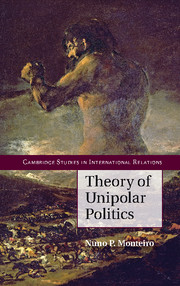Book contents
- Frontmatter
- Dedication
- Epigraph
- Contents
- Acknowledgments
- 1 Introduction
- 2 Conceptualizing Unipolarity
- 3 The Scope of Unipolar Strategic Choice
- 4 The Sources of Competition under Unipolarity
- 5 Competition in the Post–Cold War Era
- 6 The Sources of Conflict under Unipolarity
- 7 Conflict in the Post–Cold War Era
- 8 Conclusion
- Bibliography
- Index
6 - The Sources of Conflict under Unipolarity
Published online by Cambridge University Press: 05 June 2014
- Frontmatter
- Dedication
- Epigraph
- Contents
- Acknowledgments
- 1 Introduction
- 2 Conceptualizing Unipolarity
- 3 The Scope of Unipolar Strategic Choice
- 4 The Sources of Competition under Unipolarity
- 5 Competition in the Post–Cold War Era
- 6 The Sources of Conflict under Unipolarity
- 7 Conflict in the Post–Cold War Era
- 8 Conclusion
- Bibliography
- Index
Summary
If, as we established in Chapter 4, unipolarity may be durable, the question of whether it is peaceful acquires great importance. Although a good deal of attention has been devoted to identifying the causal mechanisms through which conflict may emerge in a world with two or more great powers, there is little if any scholarship on the sources of conflict in a unipolar world. The conventional wisdom on the question is that unipolarity is a peaceful configuration of the international system. In this respect, Wohlforth's words ring as true of extant scholarship today as they did in 1999:
When balance-of-power theorists argue that the post-Cold War world is headed toward conflict, they are not claiming that unipolarity causes conflict. Rather, they are claiming that unipolarity leads quickly to bi- or multipolarity. It is not unipolarity's peace but its durability that is in dispute.
Still, there are at least two reasons to look further into the sources of conflict in a unipolar world. Theoretically, we do not possess a good grasp of the consequences of the unipole's strategic choices for the likelihood and type of conflict under unipolarity. What would be the consequences for peace of the unipole implementing each of the economic and military strategies it has at its disposal? What would be the conflict cost of each strategy? More specifically, would defensive accommodation – the only strategy that makes for a durable unipolar world, entailing no competition cost – be conducive to a peaceful international system? Or would it entail a conflict cost for the unipole, triggering mechanisms that would be likely to get the unipole involved in recurrent conflicts?
Empirically, over the last two-and-a-half decades, despite a relatively low level of overall international conflict, there has been a particularly high level of military activity involving the United States. Therefore, the view that unipolarity is peaceful seems at least partly unjustified. Yet, were these post–Cold War conflicts unrelated to the overall distribution of power?
- Type
- Chapter
- Information
- Theory of Unipolar Politics , pp. 144 - 178Publisher: Cambridge University PressPrint publication year: 2014



